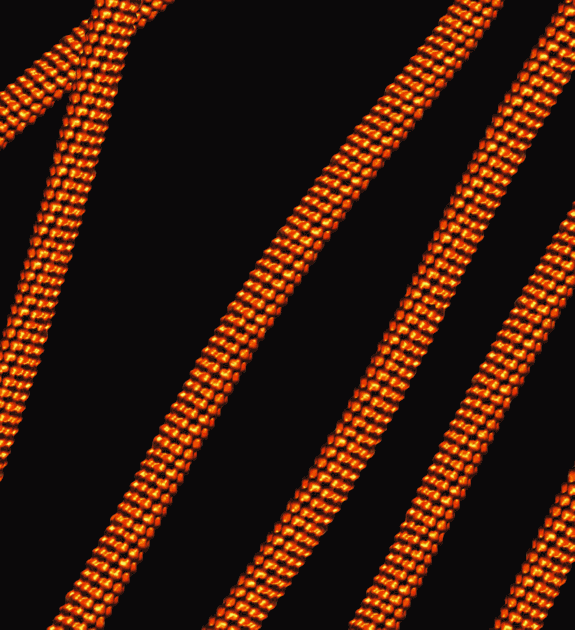Flexible filamentous viruses make up a large fraction of known plant viruses and are responsible for more than half the viral damage to crop plants throughout the world. New images of the viruses’ structures, which were poorly understood, have been revealed by scientists using a variety of sophisticated imaging techniques, including fiber diffraction from studies on one of the x-ray beamlines at the Advanced Photon Source (APS) at the U.S. Department of Energy’s (DOE’s) Argonne National Laboratory. The findings, which were published in the October 1 issue of the Journal of Virology, could lead to new ways of protecting crop plants from these viruses. The structural information that the researchers have obtained may also benefit researchers interested in using viruses as agents of biotechnology to coax plants to produce other useful products, such as pharmaceuticals.
The cost of worldwide crop losses due to plant diseases is estimated at $60 billion annually. Although there are no good estimates of the cost from plant viruses alone, the viruses are generally considered to be the second greatest contributor to those losses (after fungi). The 300-plus species of flexible filamentous viruses are responsible for more than half of all virus damage.
“These are very important plant viruses, and we knew almost nothing about their detailed structure before these studies,” says Gerald Stubbs, a professor of biological sciences at Vanderbilt University and lead author of the study. “Their flexibility made them very difficult to analyze.”
The project took more than five years to complete. The researchers, from Vanderbilt, the DOE’s Brookhaven National Laboratory, the Boston University School of Medicine, the Illinois Institute of Technology, and the University of Kentucky, studied the structures of two plant viruses from unrelated families, Potyviridae and Flexiviridae, using a combination of complementary imaging techniques: cryoelectron microscopy at Vanderbilt and scanning transmission electron microscopy (STEM) at Brookhaven in addition to the x-ray diffraction work, which was carried out on the Biophysics Collaborative Access Team 18-ID-D beamline at the APS. The end result of this effort was determination of the low-resolution structures of two species of flexible filamentous viruses: soybean mosaic virus and potato virus X.
The researchers found that the external protein coats of the two viruses are extremely similar even though they come from the two different viral families. “Although the two viruses are unrelated, they have the same outer protein coat,” says Stubbs. “Sometime in the past, a member of one family must have obtained the coat protein gene from a member of the other family, and it worked so well that pretty soon it was everywhere.”
The exchange of genes between different viruses is a well-known phenomenon and generally takes place when two viruses invade the same host, Stubbs said. This makes it quite likely that a third family of flexible filamentous viruses, Closteroviridae, has the same protein coat as well. “Actually, the coat protein is not particularly good at protecting the genome,” says Stubbs. “It must confer some evolutionary advantage, but we don’t know what that might be.”
Even after Stubbs and colleagues figured out how to make good samples and analyzed them, there were a number of ambiguities in the results. Brookhaven’s STEM technique provided the definitive answers. Although it could not determine the structure of the viral protein coat directly, STEM was able to put boundaries on the number of molecules in each “turn” of the spiral-shaped structure, and this allowed the scientists to select the correct structure from the alternatives they had come up with using the other techniques.
Some potential applications of these results include using the viral structure as the basis for engineered molecules that will interfere with the viruses’ ability to infect plants. Another possibility would be to introduce modified versions of viruses or to coat protein genes into a plant to protect it from viral and insect attacks. Yet another possible application would be to use modified viruses to introduce genes that instruct plants to make other useful products; for example, antibiotics or other drugs.
Contact: G. Stubbs, [email protected]
See: Amy Kendall, Michele McDonald, Wen Bian, Timothy Bowles, Sarah C. Baumgarten, Jian Shi, Phoebe L. Stewart, Esther Bullitt, David Gore, Thomas C. Irving, Wendy M. Havens, Said A. Ghabrial, Joseph S. Wall, and Gerald Stubbs, “Structure of Flexible Filamentous Plant Viruses,” J. Virol. 82 (19), 9546 (October 2008).
For more press coverage on this subject, see:
<http://www.genengnews.com/news/bnitem.aspx?name=42797873>
Genetic Engineering News
<http://newswire.ascribe.org/cgi-bin/behold.pl?ascribeid=20081001.101451&time=11%2008%20PDT&year=2008&public=0>
AScribe
<http://www.physorg.com/news142086368.html>
PhysOrg.com
<http://www.newswise.com/articles/view/544849/>
Newswise
http://www.wcsh6.com/news/health/story.aspx?storyid=93612&catid=8>
WCSH-TV
The Vanderbilt University news release can be found here.
The Brookhaven National Laboratory news release can be found here.
This work was supported by National Science Foundation (NSF) grant MCB-0235653 to G.S. and U.S. Department of Agriculture-National Research Initiative grant 2006-01854 to S.A.G. Fiber diffraction data analysis software was from FiberNet (www.fiberdiffraction.org), supported by NSF grant MCB-0234001. Use of the Advanced Photon Source at Argonne National Laboratory was supported by the U.S. Department of Energy, Office of Science, Office of Basic Energy Sciences, under Contract No. DE-AC02-06CH11357. Bio-CAT is a National Institutes of Health-supported Research Center (RR-08630).

